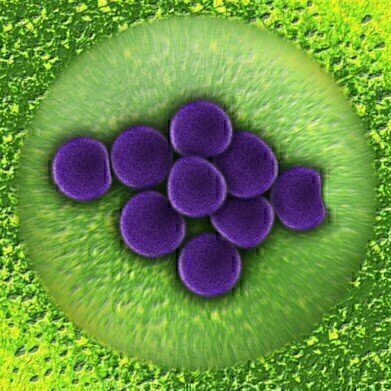-
 Antibiotic-resistant superbugs like MRSA and e.Coli could be targeted by the compound. Credit: Gerd Altman/Pixabay.
Antibiotic-resistant superbugs like MRSA and e.Coli could be targeted by the compound. Credit: Gerd Altman/Pixabay.
News
Properties of Superbug Killer Revealed by STFC Imaging Cluster
Oct 19 2020
A research team led by the University of Sheffield has used high resolution microscopy techniques at STFC’s Octopus imaging cluster to investigate the properties of a compound which kills antibiotic-resistant superbugs. The findings have led to the development of a new compound that has killed antibiotic-resistant bacteria such as methicillin-resistant Staphylococcus aureus (MRSA) and E.Coli, during tests.
Despite having different cell wall structures, the new compound was found to be able to kill both gram-negative and gram-positive bacteria by passing through the cell wall of both forms and then binding to the DNA. Doctors have not had a new treatment for gram-negative bacteria in the last 50 years and no potential drugs have entered clinical trials since 2010, so this research could lead to new treatments for these antibiotic-resistant superbugs.
The Octopus imaging cluster, part of the UK’s Central Laser Facility located in Harwell, Oxfordshire, allowed the researchers to look at how the new compound moves and act using a super resolution microscopy technique, Stimulated Emission Depletion (STED), using a specially developed dye to show fluorescence in the compound.
Dr Jorge Bernardino de la Serna from Imperial College London was part of the research team, bringing expertise from his former role as a spectroscopist at CLF and continuing visiting scientist at the facility. He said: “The cellular laboratories at CLF, equipment capabilities and know-how of the experienced staff within Octopus has been instrumental to be able to resolve the mechanism of action of this antimicrobial at the nanoscale. The ruthenium-based dyes uniquely display fluorescence properties which can nicely resolved employing a type of super resolution microscopy, STED (Stimulation Emission Depletion).”
The University of Sheffield’s Professor of Bio-inorganic Chemistry Jim Thomas led the research team. He said: "The identification of these novel antimicrobials and their mode of action has been greatly accelerated by the intrinsic luminescent properties. To be able to probe their uptake, intracellular localization and directly see how they kill bacteria at the amazing resolutions supplied by STED has been a huge catalyst in their development."
The research was published in Chemical Science.
Digital Edition
Lab Asia Dec 2025
December 2025
Chromatography Articles- Cutting-edge sample preparation tools help laboratories to stay ahead of the curveMass Spectrometry & Spectroscopy Articles- Unlocking the complexity of metabolomics: Pushi...
View all digital editions
Events
Jan 21 2026 Tokyo, Japan
Jan 28 2026 Tokyo, Japan
Jan 29 2026 New Delhi, India
Feb 07 2026 Boston, MA, USA
Asia Pharma Expo/Asia Lab Expo
Feb 12 2026 Dhaka, Bangladesh


















